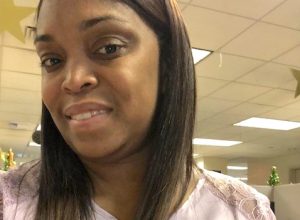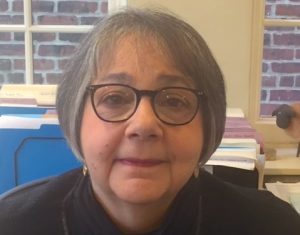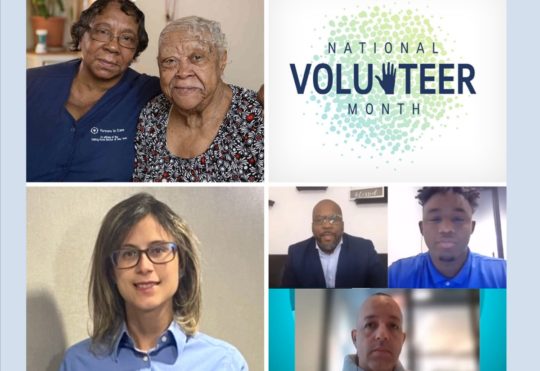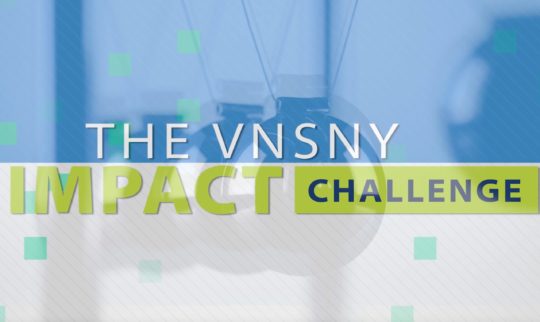It’s VNSNY Business Staff Week! How Non-Clinical Staffers Help Support Our Patients, Members and Clients
At VNSNY, everyone in the organization helps support the health and well-being of our patients, plan members and clients in some fashion—either directly or indirectly. In recognition of Business Staff Week, which extends from Sunday, November 11 through Saturday, November 17, Frontline VNSNY spoke with four non-clinical staff members about how their jobs impact the population that VNSNY serves. Here are their stories.
 Connecting Patients and Their Families with Hospice Care
Connecting Patients and Their Families with Hospice Care
When a patient is approaching his or her end of life, it’s the job of Lenora Williams, Intake Coordinator for VNSNY Hospice & Palliative Care, to help that patient and his or her family begin the process of seeking admission to hospice care. Lenora, who works on the seventh floor at 220 East 42nd Street, knows that the decision to enroll in end-of-life care can be a difficult one. To ensure the best outcome, she focuses on understanding what the patient’s needs are, and then serves as an advocate to make sure those needs are met.
“About a month ago, for example, I received a call from a woman whose mother was living in an assisted-living facility and was not receiving hospice services, although she was ready for them,” Lenora says. “Her mother wasn’t happy there, and her daughter wanted to move her to a hospice setting.” The daughter’s own home wasn’t an option, so Lenora informed the daughter about VNSNY’s Goodman Brown Hospice Residence and encouraged her to call and arrange a visit.
“A week after that, the daughter called back and said she had visited Goodman Brown and loved it,” says Lenora. As they waited for a space to open up in the eight-bed residence, Lenora reached out to the mother’s doctor for a referral to hospice care. Once word arrived several days later that a bed had become available, Lenora dispatched a hospice intake nurse to the mother’s bedside, where the nurse completed the hospice admissions process. Two days later, the mother was admitted to Goodman Brown, where, Lenora says, “she is doing well.”
In another recent case, Lenora’s empathy made all the difference. “I received a call from the daughter of an elderly man who lived at home and was failing,” she recalls. “The caller explained that her father was very stubborn. He was a former Navy pilot, and he refused to go into hospice care. He kept telling her, ‘I’m not ready to die.’”
Lenora called the father up. “Since he didn’t want to use the word hospice, I used the term ‘comfort care’ with him,” she says. “I told him, ‘We thank you for your service as a veteran, and we just want to help you in return.’” The father agreed to have a intake nurse visit him at home, and Lenora carefully selected a nurse she thought he would respond well to.
“We have amazing intake nurses in hospice, and I try to match them to just the right patients,” says Lenora. “When the patient and a nurse are a good fit, everything works out. In this case, when the nurse got there she found that the patient’s legs were bothering him so much he couldn’t walk. She explained how much more mobile he would be with a hospice nurse checking on him daily and caring for him. He agreed to be admitted to hospice then and there.”
 A Helping Hand for CHOICE Members in Need
A Helping Hand for CHOICE Members in Need
From her desk at 500 7th Avenue, Carmen Perdomo has helped CHOICE plan members with every type of issue imaginable, from arranging doctor’s appointments to making sure prescriptions for medications and medical equipment get filled. Using a combination of patience and unswerving persistence, Carmen, who is a CHOICE Call Center Member Services Representative for the CHOICE SelectHealth HIV Special Needs Plan, steadily navigates the healthcare bureaucracy until each member’s problem is resolved.
Carmen also understands that certain members need an extra dose of attention in order to achieve the best possible outcome. Ms. Smith (not her real name) was one such member. “She joined SelectHealth about a year ago, and I first got involved her when she was having dental work done at a major New York medical center,” says Carmen. “They wanted her to get a special type of CT scan, but their scanning facility wouldn’t allow that scan to be billed to Medicaid, which is what the SelectHealth plan calls for.” After a series of phone calls, Carmen located another facility that could do the unique scan and would bill it to Medicaid. Getting the results sent to the original dental team was another challenge, since at first the scanning facility couldn’t locate the scan results in their records. “Eventually I got everything worked out, and Ms. Smith went on to have her dental procedure performed successfully,” Carmen says.
From that point on, Ms. Smith worked with Carmen whenever possible. “I explained to her that any one of the representatives at our Call Center is equally capable of helping her,” says Carmen, “but she was very comfortable with me, so I would try to take on her requests whenever possible.” Carmen came to know her preferences—such as the fact that she likes to have doctors’ appointments scheduled in the morning—and patiently worked through other matters such as getting Ms. Smith a properly fitted knee brace. “I was able to reach out the vendor, and they actually went to her home to measure her knee,” Carmen notes.
Most recently, Ms. Smith was told her orthopedist was suddenly no longer in the SelectHealth plan. Caren conferred with CHOICE Provider Relations and found that the specialist’s office was mistaken, and the doctor was still in network. “I’m getting ready to call Ms. Smith now, to tell her that she can go ahead and keep her appointment in December,” says Carmen.
Above all, Carmen adds, she and the rest of the Call Center team are focused on one overriding goal: To make sure that CHOICE members are satisfied, and that they are receiving the medical care they need. “No matter what the issue is, I’ll keep following up until it’s resolved,” she says. “We do our best, so we can make sure that our members get the best.”
 Have Technology, Will Trouble-Shoot
Have Technology, Will Trouble-Shoot
Whenever someone at VNSNY has an equipment glitch—a PowerPoint projector that’s not working, a remote Internet connection that’s not going through, a desk phone that’s on the blink—Sunny Babbar, Supervisor, System Administrative Support, is on it.
“My team’s job is to resolve problems with people’s laptops, desktop computers, printers, issues logging on from home, things like that,” says Sunny, who works out of 220 East 42nd Street. “Every day is a different mix of issues that can involve anything related to technology at VNSNY. My work starts from the minute I walk into the office each day, and lasts until the minute I leave.”
By enabling VNSNY employees to do their jobs supporting patient and member care, Sunny and his eight-person team impact virtually every corner of VNSNY. Most staff requests come to the team through the VNSNY IT Help Desk, which creates a work ticket for each request. His squad services all VNSNY regions except Brooklyn, which has its own dedicated trouble-shooting group, and they’ll travel to other sites as needed. The biggest single challenge that Sunny’s team has faced in recent months, he says, involved the big move of Manhattan staff from 1250 Broadway to VNSNY’s new 42nd Street office.
“I came over on the day the first wave moved in,” notes Sunny. “It was a busy week! There’s a lot of great new equipment at 220 East 42nd, but we were still getting to know all of it. Meanwhile we were also making sure everyone’s new work areas were set up and working properly, and that all the technology in the meeting rooms was operating.”
The team’s challenges ranged from figuring out, that very first morning, how to unlock the desktops so the placement of computer monitors and mousepads could be adjusted (“It was a simple latch, but we needed the move consultants to show us how it worked,” smiles Sunny), to making sure the entire CHHA staff had their new electronic medical record software, HomeCare HomeBase, installed and working on their computers.
Other challenges at 220 East 42nd included making sure the presentation equipment was working in all the new conference rooms so that training sessions could move forward as scheduled, and getting the video monitors and in-house speakers up and running in time for the enterprise-wide 125th anniversary breakfast celebration in late October. “We got through it all as a group by starting early, putting our heads together and figuring everything out,” says Sunny.
The one thing that didn’t go as planned, he adds, was his temporary return to 1250 Broadway following the first wave of the move. “I was originally supposed to be at the new office for just a few days to make sure the other team members were settled,” says Sunny. “But as it turns out, there was so much to do, I never got back the old building. I’ve been based here at 220 ever since!”
 Securing Funding Support for Vital Programs
Securing Funding Support for Vital Programs
VNSNY’s Bronx Nurse-Family Partnership (NFP) has gained national attention for its success. The safety-net program, in which specially trained nurses mentor young, first-time mothers from pregnancy through their child’s second birthday, has a contract with New York City’s Department of Health and Mental Hygiene, but it also gets essential additional funding from Robin Hood, New York’s largest private poverty-fighting foundation—which is where Jacqueline Halpern, VNSNY’s Director of Foundation & Corporate Relations, comes in.
“Part of my work in securing philanthropic support for programs like the VNSNY Nurse-Family Partnership involves acting like a bridge between our program staff needs and the requirements of the prospective funder,” says Jackie, who, more often than not, works out of VNSNY’s 70th Street office. “Getting grant funding for our programs is always a collaborative effort between me and those responsible for actually running the programs. Under the direction of Carol Odnoha, our NFP program has become one of the best in the U.S., and Robin Hood’s support, through its enhancements to our DOHMH contract, has helped make that possible.”
In addition to NFP, Jackie has helped secure grant funding for numerous other VNSNY programs, from support services for Chinatown seniors to VNSNY’s recently launched LGBT Outreach initiative. Her role includes, but is not limited to, identifying foundations that are a good potential fit with a given program, then reaching out to that foundation to explain the program’s impact and how it would benefit from their support.
For Robin Hood, it was big plus that VNSNY’s NFP program outcomes for its client moms and their children are consistently excellent and show the program produces life-long benefits. “Robin Hood first funded our NFP back in 2007 with a $360,000 grant—$1,000 for each of the 360 families in the program,” says Jackie. “Among the critical areas of Robin Hood’s support is mental health, which involves arranging services for our NFP clients before problems turn into a crisis and providing mental health training to our NFP nurses.”
These types of mental health services are not covered by NFP’s contract with New York City, she notes, but they can be vitally important for young, low-income mothers coping with a myriad of stresses. As the Bronx NFP program grew to 800 families over the past decade, Robin Hood has agreed to increase its annual grant to the program proportionately through ongoing discussions that Jackie has spearheaded. More recently, with Jackie’s encouragement, they provided even more supplemental funding, bringing their total yearly support for the Bronx NFP to between $950,000 and a million dollars.
“Robin Hood is very pleased that the program performs so well, and that their funding is supporting such consistently good outcomes for our NFP clients,” says Jackie. “At VNSNY, we’re grateful in turn that Robin Hood has increased its funding over the years to keep pace with the program’s growth. Personally, I feel great pride in having successfully contributed to that.”

